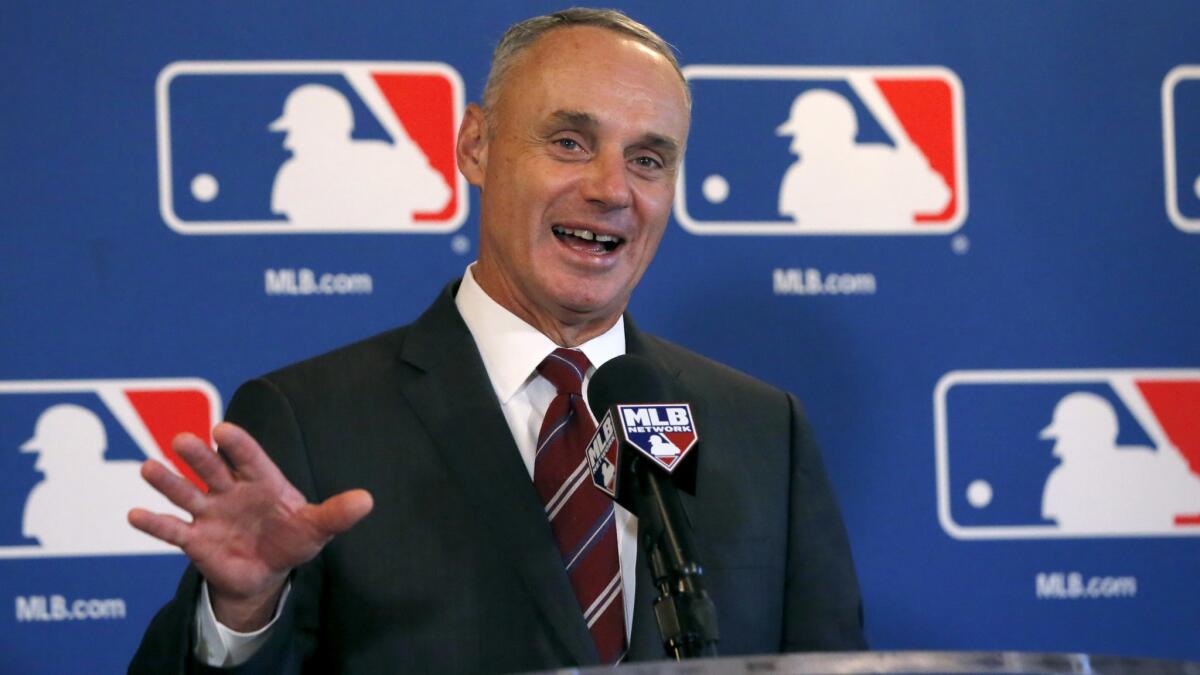MLB players and owners avert lockout with new labor deal only hours before deadline

In the end, baseballâs labor talks yielded to the moral of a fable: Donât get too greedy, lest you kill the golden goose.
With three hours before the collective bargaining agreement expired, and with the threat of a lockout in the absence of a new one, Major League Baseball players and owners agreed Wednesday night to a new five-year deal.
The pact would extend through 2021, which would mark 26 years without a strike or lockout. In the previous 24 years, MLB had eight work stoppages.
The off-season can now begin in earnest, starting with next weekâs winter meetings. Some teams had been reluctant to make major moves until knowing whether signings and payrolls would be governed by current rules or new rules.
In a statement, the league said the âtentative five-year labor agreementâ would be subject to ratification by players and owners and said âthe parties continue to draft the entirety of the tentative agreement.â
The new deal is believed to be limited to incremental changes, a recognition by both sides that a sport now generating $10 billion per year had become far too lucrative to risk a shutdown.
Although the league said it would not announce any details of the agreement until the deal was finalized, various media reports indicated how few of the supposedly major proposals actually had been adopted.
Elimination of free-agent compensation? Didnât happen, but the system got better for players.
An international draft? Didnât happen, but the system got better for owners.
An extra player on each team? Didnât happen.
A limit to expanded September rosters? Didnât happen.
Teams losing top free agents still could get a draft pick or two in return, but that pick would no longer be in the first round. This provision would not take effect until next winter, so the Dodgers still would get a top draft pick as compensation if third baseman Justin Turner and/or closer Kenley Jansen sign elsewhere this winter.
In addition, the amount a team can spend on payroll before paying a luxury tax will increase, from $189 million over the past three seasons to about $195 million in 2017, with gradual increases to $210 million by 2021.
The Dodgers and New York Yankees â the only teams to pay the luxury tax more than once in the first four years of the current agreement â have expressed a desire to reduce their payrolls so as to avoid the tax.
Teams subject to the luxury tax reportedly would surrender a second-round and a fifth-round draft pick in order to sign a top free agent. Teams not subject to the luxury tax would surrender a third-round pick.
The expiring labor agreement did not anticipate the sharply rising value of draft picks in an ever-younger game, so some free agents found limited interest because a team might have to surrender a first-round pick to sign them. The Dodgers extended Howie Kendrick a qualifying offer last winter in order to get an extra draft pick when he signed elsewhere; the Dodgers re-signed him when the attached draft pick all but eliminated his market.
Although owners dropped their demand for an international draft, they will introduce tighter restrictions on spending for international amateurs. The dollar-for-dollar tax imposed in the old labor agreement did not deter big-spending teams like the Dodgers, Yankees and Boston Red Sox.
Owners declined to shorten the schedule â and give up the ticket and concession revenue that would accompany the loss of games â but did agree to sprinkle in additional off days, as players complained of marathon scheduling affecting the quality of play. As a result, starting in 2018, the season will start in the middle of the week rather than on Sunday or Monday, adding four or five off days to the schedule.
Follow Bill Shaikin on Twitter @BillShaikin
More to Read
Go beyond the scoreboard
Get the latest on L.A.'s teams in the daily Sports Report newsletter.
You may occasionally receive promotional content from the Los Angeles Times.











